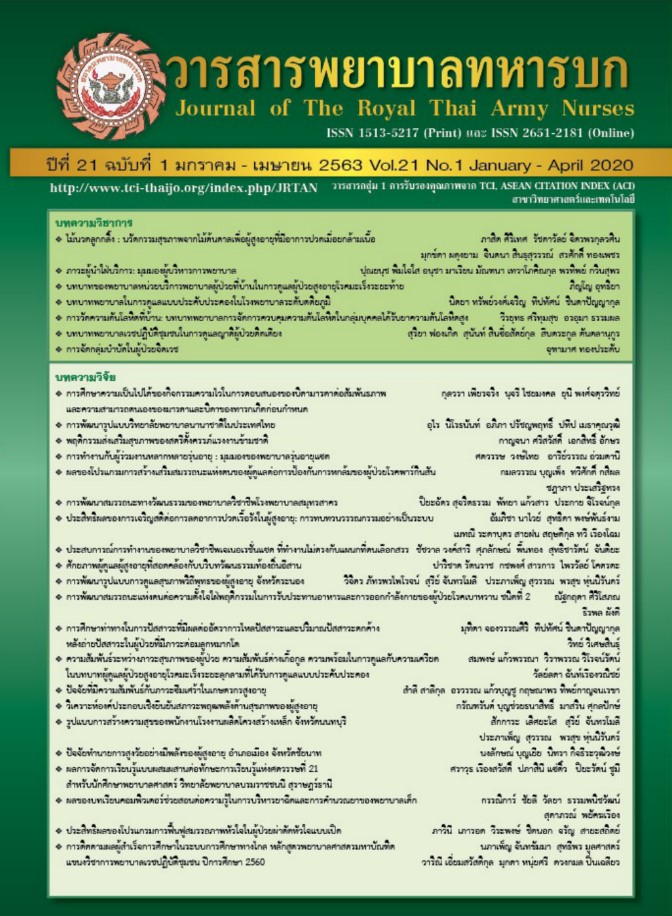A Development of Visual Imagery Based on Gestalt Training Program in Elementary School Students
Keywords:
Windows of learning, Working memory, Visual imagery, Visual imagery based on gestaltAbstract
The study was a experimental research design which aimed at investing a training program of visual imagery based on gestalt for elementary school students. The sample was 56 students. The sample was randomized by using simple random sampling into groups. Each group consisted of 28 students. The instruments used were an a training program of visual imagery based on gestalt for elementary school students, The Neglieri Nonverbal Ability Test and The Corsi Block Tapping Task. There were 10 sessions in the experiment, each session last for 50 minutes, for a total of five weeks. The experiment was divided into three phases : pretest, posttest and follow-up. The data were statistically analyzed by utilizing a repeated measures analysis of variance and paired-different test by Bonferroni method.
The research finding: 1) The interaction between experimental methods and experimental periods influenced visual imagery and working memory usage of the primary school students, with a significant difference at .05 level. 2) The primary students who received a training program of visual imagery based on gestalt in posttest possessed visual imagery and working memory higher than pretest, the follow-up possessed visual imagery and working memory higher than posttest and higher than control group with a significant difference at.05 level.
Downloads
References
2. Poonperm, R., Proyngern, J., Sunuanta, S., & Prompeng, N. Effectiveness of Question Based Learning of nursing students at The Royal Thai Army Nursing College. Journal of the Royal Thai Army Nurses. 2018; 19(3) : 126-136. (in Thai).
3. Haenjohn, J., Sirithadakunlaphat, S., & Supwirapakorn, W. Development of Training Program on Promoting Executive Functions of The Brain in Adolescents. Journal of the Royal Thai Army Nurses. 2018; 19(2): 220-230. (in Thai).
4. Cowan, N. The Magical Mystery Four: How is Working Memory Capacity Limited, and Why? Current Direction in Psychological Science. 2010; 19(1): 51-57.
5. Baddeley, A. D. Working memory. New York: Current Biology; 2010.
6. Ponmark, J., Thisara, P., Weiangkham, D., & Duangpanya, A. Development of a Family Participation Model for Promoting Child Development: A Case Study of Ban Sanpamuang Child Care Center, Mueang District, Phayao Province. Journal of the Royal Thai Army Nurses. 2019; 20(2): 241-250. (in Thai).
7. Haenjohn, J. Cognitive Psychology. Bangkok: Grand point; 2018. (in Thai)
8. Snyder, A. C., Shpaner, M., Molholm, S., & Foxe, J. J. Visual object processing as a function of stimulus energy, Retinal eccentricity and gestalt configuration : A high-density electrical mapping study. Neuroscience. 2010 ; 221, 1-11.
9. Kosslyn, S. M., Margolis, J. A., Barrett, A. M., Goldknopf, E. J., & Daly, P. F. Age differences in imagery abilities. Child Development. 1990; 61(4): 995-1010.
10. Kosslyn, S. M. Scanning visual images: Some structural implications. Attention Perception & Psychophysics. 1973; 14(1): 90-94.
11. Tatsanasomboon, J., et al. General Psychology. Bangkok: Thammasat University Press; 2008. (in Thai)
12. Kosslyn, S. M. Scanning visual images: Some structural implications. Attention Perception & Psychophysics. 1973; 14(1): 90-94.
13. Kosslyn, S. M., Ball, T. M., & Reiser, B. J. Visual images preserve metric spatial information: Evidence from studies of image scanning. Journal of Experimental Psychology: Human Perception and Performance. 1978; 4(1): 47-60.
14. Rennig, J., & Karnath, H. O. Stimulus size mediates Gestalt processes in object perception - evidence from simultanagnosia. Neuropsychologia. 2016; 89: 66-73.
15. Lall, G. R., and Lall, B.M. Ways children learn. Illinois: Charles C. Thomas Publishers; 1983.
16. Bizzaroa, M., Giofrèb, D., Girellia, L., Cornoldi, C. Arithmetic, working memory, and visuospatial imagery abilities in children with poor geometric learning. Learning and Individual Differences. 2018; 62: 79-88.
Downloads
Published
How to Cite
Issue
Section
License
บทความหรือข้อคิดเห็นใดใดที่ปรากฏในวารสารพยาบาลทหารบกเป็นวรรณกรรมของผู้เขียน ซึ่งบรรณาธิการหรือสมาคมพยาบาลทหารบก ไม่จำเป็นต้องเห็นด้วย
บทความที่ได้รับการตีพิมพ์เป็นลิขสิทธิ์ของวารสารพยาบาลทหารบก
The ideas and opinions expressed in the Journal of The Royal Thai Army Nurses are those of the authors and not necessarily those
of the editor or Royal Thai Army Nurses Association.






